Morse Code Recognition Based on a Flexible Tactile Sensor with Carbon Nanotube/Polyurethane Sponge Material by the Long Short-Term Memory Model
Abstract
1. Introduction
2. Design and Preparation
2.1. Structure Design of the CNT/PUS Sensor
2.2. Preparation of the CNT/PUS Sensor
2.3. Performance Testing of the CNT/PUS Sensor
2.4. Sensing Mechanism of the Flexible Tactile Sensor
3. Data Acquisition for Morse Code Expression
3.1. The Expression of Morse Code
3.2. Data Collection for Morse Code from the CNT/PUS Sensor
4. Data Preprocessing
4.1. Data Smoothing for the Morse Code from the Sensor
4.2. Normalization for the Morse Code from the Sensor
5. Morse Code Recognition Based on the LSTM Model
5.1. Principle of the LSTM Network
5.2. Construction of the LSTM Model for the Preprocessed Tactile Data
5.3. Evaluation Metrics
5.4. Analysis of Recognition Results
5.4.1. Recognition Results for Morse Code Based on the LSTM Model
5.4.2. Comparison Based on Different Models for Morse Code Recognition
6. Conclusions
Author Contributions
Funding
Data Availability Statement
Conflicts of Interest
References
- Zhang, X.; Li, N.; Wang, G.; Zhang, C.; Zhang, Y.; Zeng, F.; Liu, H.; Yi, G.; Wang, Z. Research status of polysiloxane-based piezoresistive flexible human electronic sensors. RSC Adv. 2023, 13, 16693–16711. [Google Scholar] [CrossRef] [PubMed]
- Song, Y.; Li, M.; Wang, F.; Lv, S. Contact Pattern Recognition of a Flexible Tactile Sensor Based on the CNN-LSTM Fusion Algorithm. Micromachines 2022, 13, 1053. [Google Scholar] [CrossRef] [PubMed]
- Song, Y.; Lv, S.; Wang, F.; Li, M. Hardness-and-Type Recognition of Different Objects Based on a Novel Porous Graphene Flexible Tactile Sensor Array. Micromachines 2023, 14, 217. [Google Scholar] [CrossRef]
- Cao, Y.; Li, T.; Gu, Y.; Luo, H.; Wang, S.; Zhang, T. Fingerprint-Inspired Flexible Tactile Sensor for Accurately Discerning Surface Texture. Small 2018, 14, 1703902. [Google Scholar] [CrossRef] [PubMed]
- Wang, Y.; Chen, J.; Mei, D. Recognition of surface texture with wearable tactile sensor array: A pilot Study. Sens. Actuators A Phys. 2020, 307, 111972. [Google Scholar] [CrossRef]
- Su, Y.; Ma, C.; Chen, J.; Wu, H.; Luo, W.; Peng, Y.; Luo, Z.; Li, L.; Tan, Y.; Omisore, O.M.; et al. Printable, Highly Sensitive Flexible Temperature Sensors for Human Body Temperature Monitoring: A Review. Nanoscale Res. Lett. 2020, 15, 200. [Google Scholar] [CrossRef]
- Li, W.; Jin, X.; Han, X.; Li, Y.; Wang, W.; Lin, T.; Zhu, Z. Synergy of porous structure and microstructure in piezoresistive material for high-performance and flexible pressure sensors. ACS Appl. Mater. Interfaces 2021, 13, 19211–19220. [Google Scholar] [CrossRef]
- Liu, J.; Liu, N.; Hashimoto, K.; Meng, C.; Guo, S. Touch position identification based on a flexible array-less supercapacitive tactile sensor. AIP Adv. 2019, 9, 015026. [Google Scholar] [CrossRef]
- Drimus, A.; Kootstra, G.; Bilberg, A.; Kragic, D. Design of a flexible tactile sensor for classification of rigid and deformable objects. Robot. Auton. Syst. 2014, 62, 3–15. [Google Scholar] [CrossRef]
- Luo, Y.; Xiao, X.; Chen, J.; Li, Q.; Fu, H. Machine-Learning-Assisted Recognition on Bioinspired Soft Sensor Arrays. ACS Nano 2022, 16, 6734–6743. [Google Scholar] [CrossRef]
- Mao, R.; Yao, W.; Qadir, A.; Chen, W.; Gao, W.; Xu, Y.; Hu, H. 3-D graphene aerogel sphere-based flexible sensors for healthcare applications. Sens. Actuators A Phys. 2020, 312, 112144. [Google Scholar] [CrossRef]
- Gao, W.; Emaminejad, S.; Nyein, H.Y.Y.; Challa, S.; Chen, K.; Peck, A.; Fahad, H.M.; Ota, H.; Shiraki, H.; Kiriya, D.; et al. Fully integrated wearable sensor arrays for multiplexed in situ perspiration analysis. Nature 2016, 529, 509–514. [Google Scholar] [CrossRef]
- Su, Y.; Zheng, L.; Yao, D.; Zhang, X.; Chen, H.; Xu, H. Robust physiological signal monitoring by a flexible piezoresistive sensor microstructured with filamentating laser pulses. Sens. Actuators A Phys. 2021, 331, 112907. [Google Scholar] [CrossRef]
- Wen, F.; Zhang, Z.; He, T.; Lee, C. AI enabled sign language recognition and VR space bidirectional communication using triboelectric smart glove. Nat. Commun. 2021, 12, 5378. [Google Scholar] [CrossRef] [PubMed]
- Sundaram, S.; Kellnhofer, P.; Li, Y.; Zhu, J.-Y.; Torralba, A.; Matusik, W. Learning the signatures of the human grasp using a scalable tactile glove. Nature 2019, 569, 698–702. [Google Scholar] [CrossRef] [PubMed]
- Niu, H.; Li, H.; Gao, S.; Li, Y.; Wei, X.; Chen, Y.; Yue, W.; Zhou, W.; Shen, G. Perception-to-cognition tactile sensing based on artificial-intelligence-motivated human full-skin bionic electronic skin. Adv. Mater. 2022, 34, 2202622. [Google Scholar] [CrossRef] [PubMed]
- Zhou, Z.; Chen, K.; Li, X.; Zhang, S.; Wu, Y.; Zhou, Y.; Meng, K.; Sun, C.; He, Q.; Fan, W. Sign-to-speech translation using machine-learning-assisted stretchable sensor arrays. Nat. Electron. 2020, 3, 571–578. [Google Scholar] [CrossRef]
- Wan, C.; Chen, G.; Fu, Y.; Wang, M.; Matsuhisa, N.; Pan, S.; Pan, L.; Yang, H.; Wan, Q.; Zhu, L. An artificial sensory neuron with tactile perceptual learning. Adv. Mater. 2018, 30, 1801291. [Google Scholar] [CrossRef]
- Zhu, M.; Sun, Z.; Zhang, Z.; Shi, Q.; He, T.; Liu, H.; Chen, T.; Lee, C. Haptic-feedback smart glove as a creative human-machine interface (HMI) for virtual/augmented reality applications. Sci. Adv. 2020, 6, eaaz8693. [Google Scholar] [CrossRef] [PubMed]
- Chun, K.S.; Kang, Y.J.; Lee, J.Y.; Nguyen, M.; Lee, B.; Lee, R.; Jo, H.H.; Allen, E.; Chen, H.; Kim, J. A skin-conformable wireless sensor to objectively quantify symptoms of pruritus. Sci. Adv. 2021, 7, eabf9405. [Google Scholar] [CrossRef]
- Song, Y.; Liu, M.; Wang, F.; Zhu, J.; Hu, A.; Sun, N. Gesture Recognition Based on a Convolutional Neural Network-Bidirectional Long Short-Term Memory Network for a Wearable Wrist Sensor with Multi-Walled Carbon Nanotube/Cotton Fabric Material. Micromachines 2024, 15, 185. [Google Scholar] [CrossRef] [PubMed]
- Gao, Z.; Ren, B.; Fang, Z.; Kang, H.; Han, J.; Li, J. Accurate recognition of object contour based on flexible piezoelectric and piezoresistive dual mode strain sensors. Sens. Actuators A Phys. 2021, 332, 113121. [Google Scholar] [CrossRef]
- Mekruksavanich, S.; Jitpattanakul, A. A Deep Learning Network with Aggregation Residual Transformation for Human Activity Recognition Using Inertial and Stretch Sensors. Computers 2023, 12, 141. [Google Scholar] [CrossRef]
- Yu, Q.; Zhang, P.; Chen, Y. Human Motion State Recognition Based on Flexible, Wearable Capacitive Pressure Sensors. Micromachines 2021, 12, 1219. [Google Scholar] [CrossRef]
- Adepu, V.; Tathacharya, M.; Cs, R.; Mattela, V.; Sahatiya, P. TeNWs/Ti3C2Tx Nanohybrid-Based Flexible Pressure Sensors for Personal Safety Applications Using Morse Code. ACS Appl. Nano Mater. 2022, 5, 18209–18219. [Google Scholar] [CrossRef]
- Sadiq, H.; Hui, H.; Huang, S.; Mahmood, K.; Sharif, M.H.; Ali, I. A Flexible Pressure Sensor Based on PDMS-CNTs Film for Multiple Applications. IEEE Sens. J. 2022, 22, 3033–3039. [Google Scholar] [CrossRef]
- Wang, F.; Zhang, W.; Song, Y.; Jiang, X.; Sun, N. Wearable and Cost-Effective Pressure Sensor Based on a Carbon Nanotube/Polyurethane Sponge for Motion Detection and Gesture Recognition. ACS Appl. Electron. Mater. 2023, 5, 6704–6715. [Google Scholar] [CrossRef]
- Zhao, X.; Mei, D.; Tang, G.; Zhao, C.; Wang, J.; Luo, M.; Li, L.; Wang, Y. Strain and Pressure Sensors Based on MWCNT/PDMS for Human Motion/Perception Detection. Polymers 2023, 15, 1386. [Google Scholar] [CrossRef] [PubMed]
- Qiu, J.; Guo, X.; Chu, R.; Wang, S.; Zeng, W.; Qu, L.; Zhao, Y.; Yan, F.; Xing, G. Rapid-Response, Low Detection Limit, and High-Sensitivity Capacitive Flexible Tactile Sensor Based on Three-Dimensional Porous Dielectric Layer for Wearable Electronic Skin. ACS Appl. Mater. Interfaces 2019, 11, 40716–40725. [Google Scholar] [CrossRef]
- Chen, X.; Zhang, D.; Luan, H.; Yang, C.; Yan, W.; Liu, W. Flexible Pressure Sensors Based on Molybdenum Disulfide/Hydroxyethyl Cellulose/Polyurethane Sponge for Motion Detection and Speech Recognition Using Machine Learning. ACS Appl. Mater. Interfaces 2022, 15, 2043–2053. [Google Scholar] [CrossRef] [PubMed]
- Xiong, Y.; Zhu, Y.; Liu, X.; Zhu, P.; Hu, Y.; Sun, R.; Wong, C.-P. A flexible pressure sensor based on melamine foam capped by copper nanowires and reduced graphene oxide. Mater. Today Commun. 2020, 24, 100970. [Google Scholar] [CrossRef]
- Ni, Y.; Feng, J.; Liu, J.; Yu, H.; Wei, H.; Du, Y.; Liu, L.; Sun, L.; Zhou, J.; Xu, W. An Artificial Nerve Capable of UV-Perception, NIR–Vis Switchable Plasticity Modulation, and Motion State Monitoring. Adv. Sci. 2021, 9, 2102036. [Google Scholar] [CrossRef] [PubMed]
- Ni, Y.; Yang, L.; Feng, J.; Liu, J.; Sun, L.; Xu, W. Flexible optoelectronic neural transistors with broadband spectrum sensing and instant electrical processing for multimodal neuromorphic computing. SmartMat 2022, 4, e1154. [Google Scholar] [CrossRef]
- Ni, Y.; Liu, J.; Han, H.; Yu, Q.; Yang, L.; Xu, Z.; Jiang, C.; Liu, L.; Xu, W. Visualized in-sensor computing. Nat. Commun. 2024, 15, 3454. [Google Scholar] [CrossRef] [PubMed]
- Yu, F.; Cai, J.C.; Zhu, L.Q.; Sheikhi, M.; Zeng, Y.H.; Guo, W.; Ren, Z.Y.; Xiao, H.; Ye, J.C.; Lin, C.-H.; et al. Artificial Tactile Perceptual Neuron with Nociceptive and Pressure Decoding Abilities. ACS Appl. Mater. Interfaces 2020, 12, 26258–26266. [Google Scholar] [CrossRef] [PubMed]
- Wang, X.; Li, E.; Liu, Y.; Lan, S.; Yang, H.; Yan, Y.; Shan, L.; Lin, Z.; Chen, H.; Guo, T. Stretchable vertical organic transistors and their applications in neurologically systems. Nano Energy 2021, 90, 106497. [Google Scholar] [CrossRef]
- Hochreiter, S.; Schmidhuber, J. Long short-term memory. Neural Comput. 1997, 9, 1735–1780. [Google Scholar] [CrossRef] [PubMed]
- Abdullah, A.H.; Ismail, Z. Butterfly pea flower as a stabilizer for shear exfoliated graphene: Green material for motion monitoring and Morse code sensor. Appl. Nanosci. 2022, 13, 4593–4603. [Google Scholar] [CrossRef]
- Peng, Y.; Wang, J.; Pang, K.; Liu, W.; Meng, J.; Li, B. A Physiology-Based Flexible Strap Sensor for Gesture Recognition by Sensing Tendon Deformation. IEEE Sens. J. 2021, 21, 9449–9456. [Google Scholar] [CrossRef]
- Al-Handarish, Y.; Omisore, O.M.; Chen, J.; Cao, X.; Akinyemi, T.O.; Yan, Y.; Wang, L. A Hybrid Microstructure Piezoresistive Sensor with Machine Learning Approach for Gesture Recognition. Appl. Sci. 2021, 11, 7264. [Google Scholar] [CrossRef]
- Wei, Z.; Li, Z.; Han, S. YFDM: YOLO for detecting Morse code. Sci. Rep. 2023, 13, 20614. [Google Scholar] [CrossRef] [PubMed]
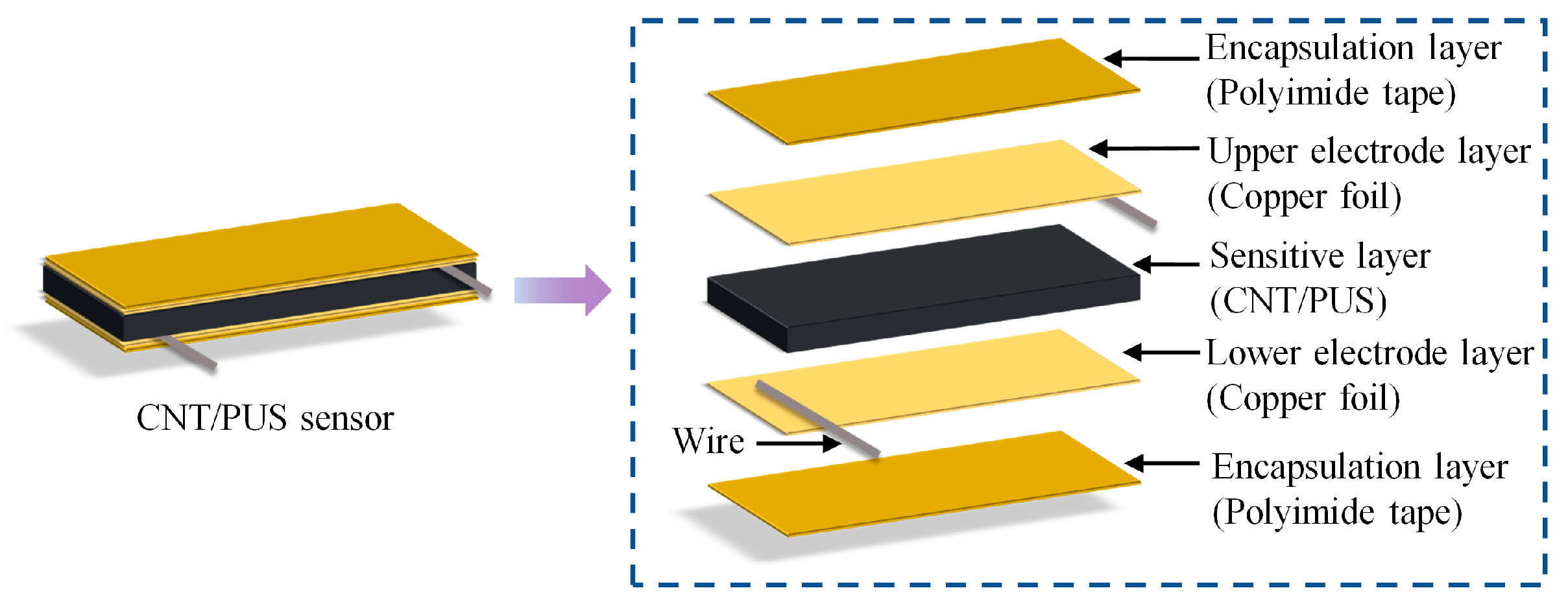
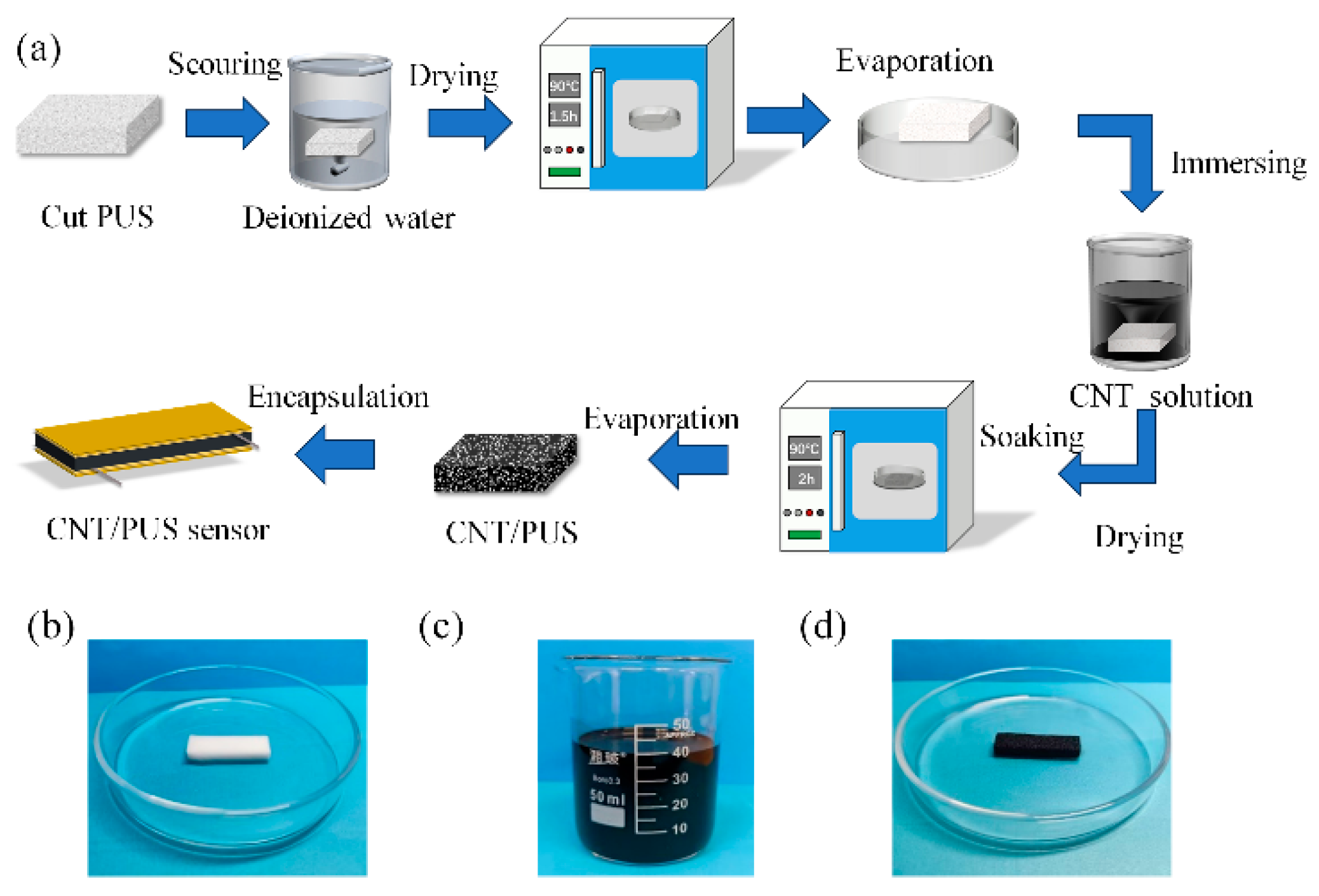
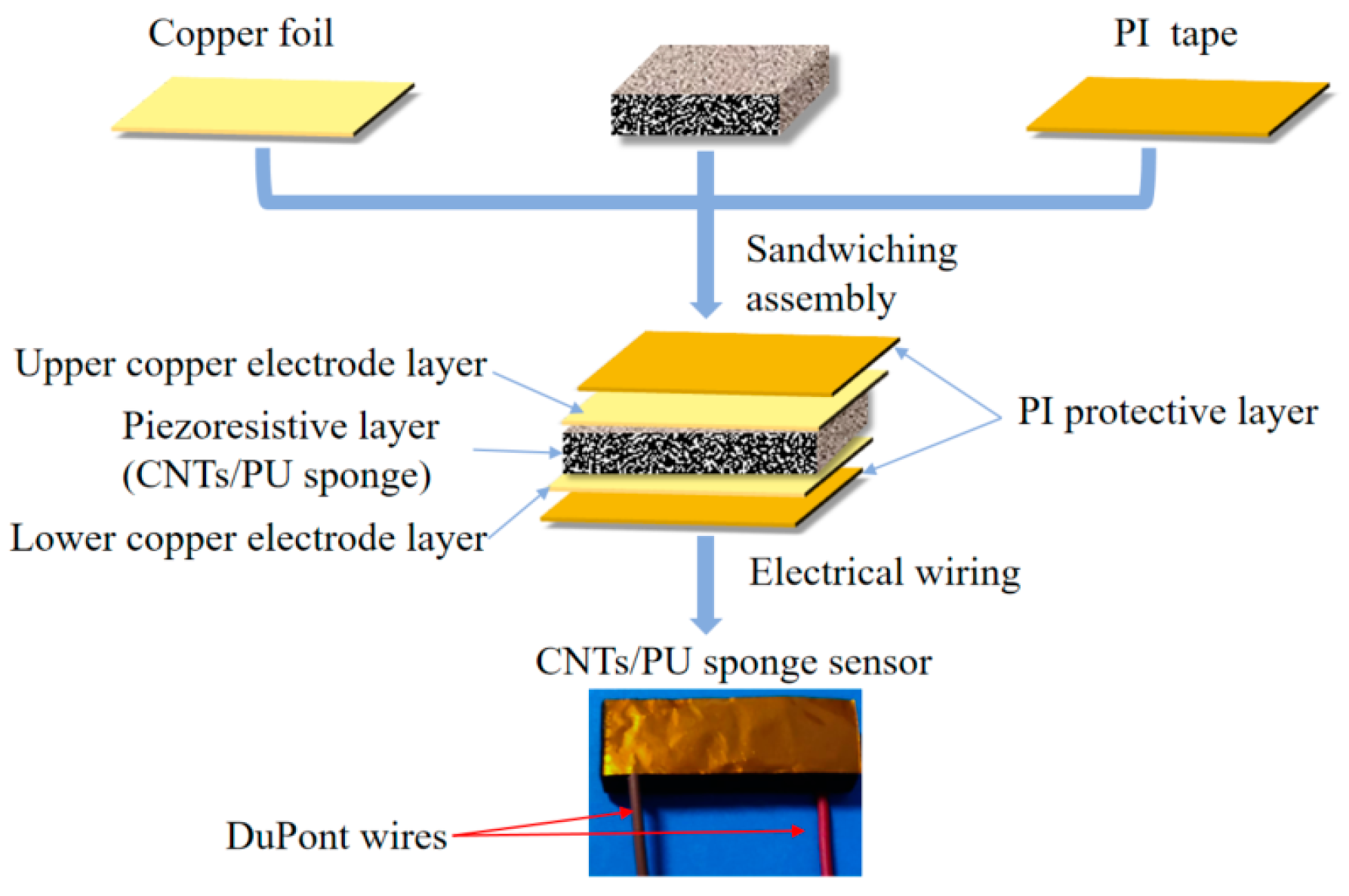

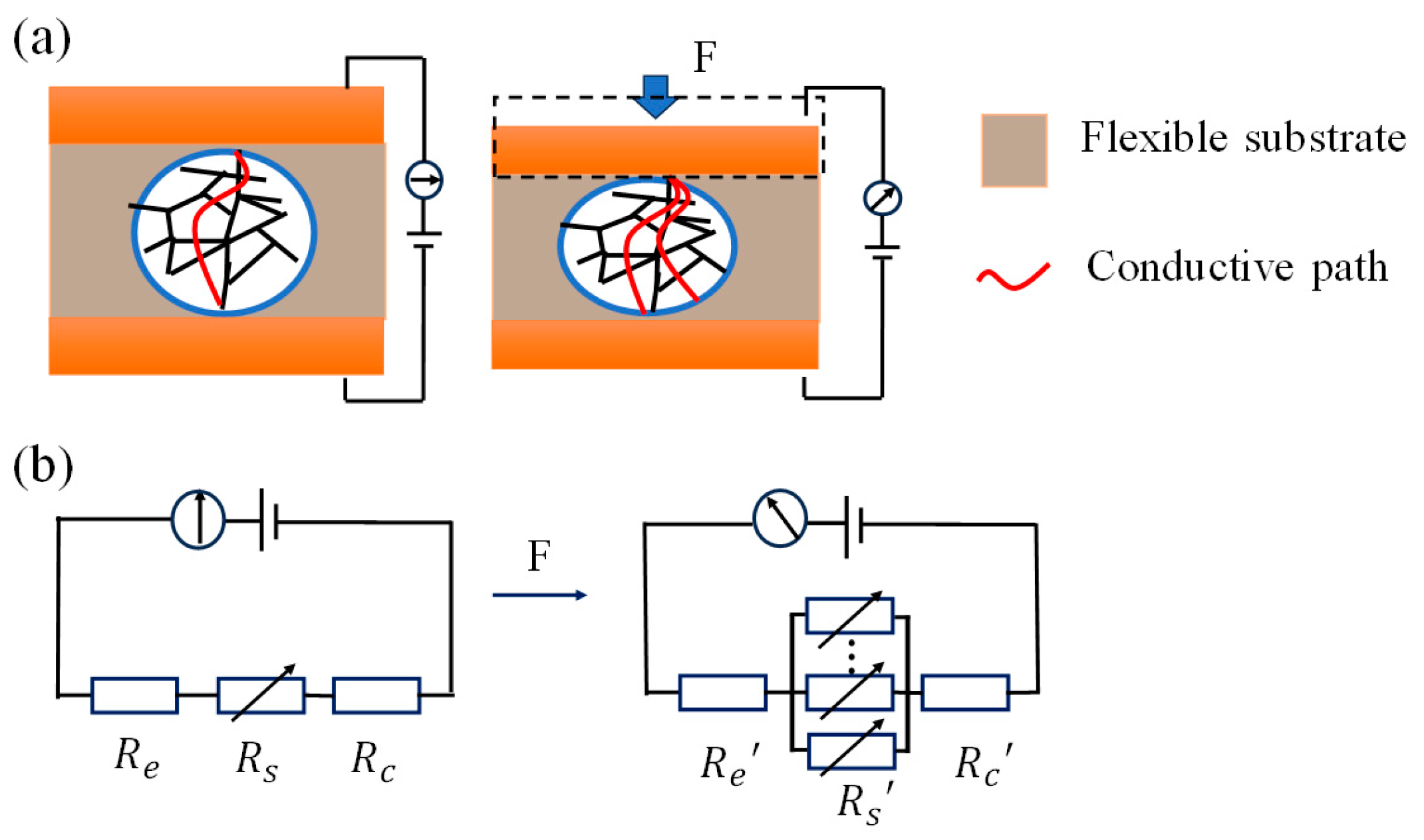

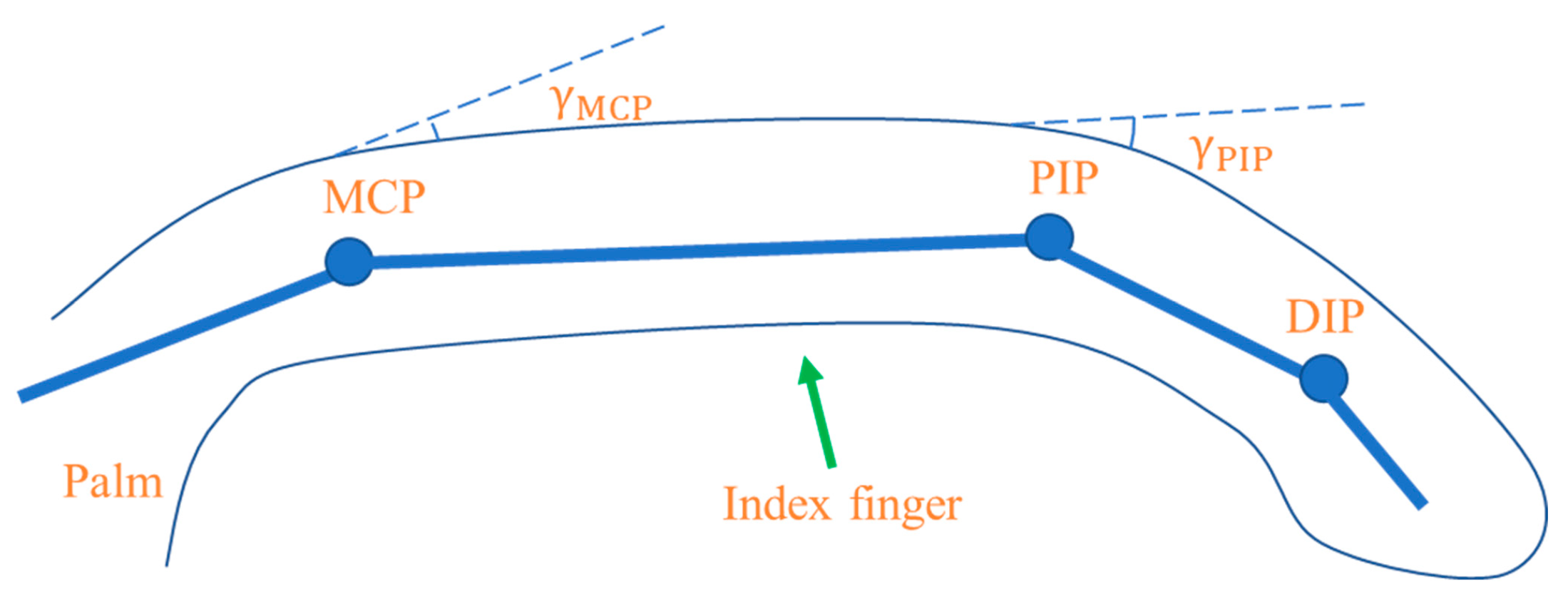

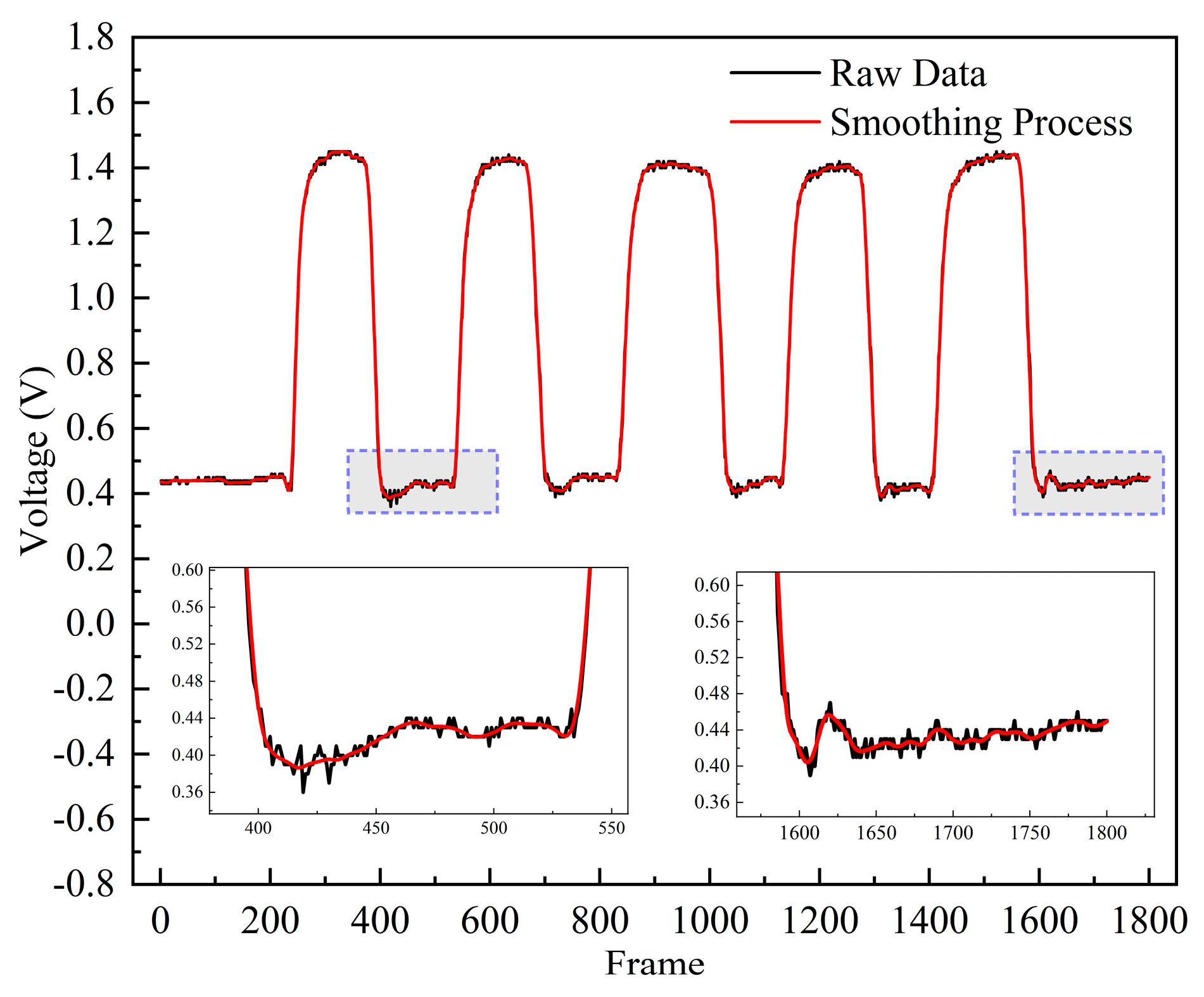

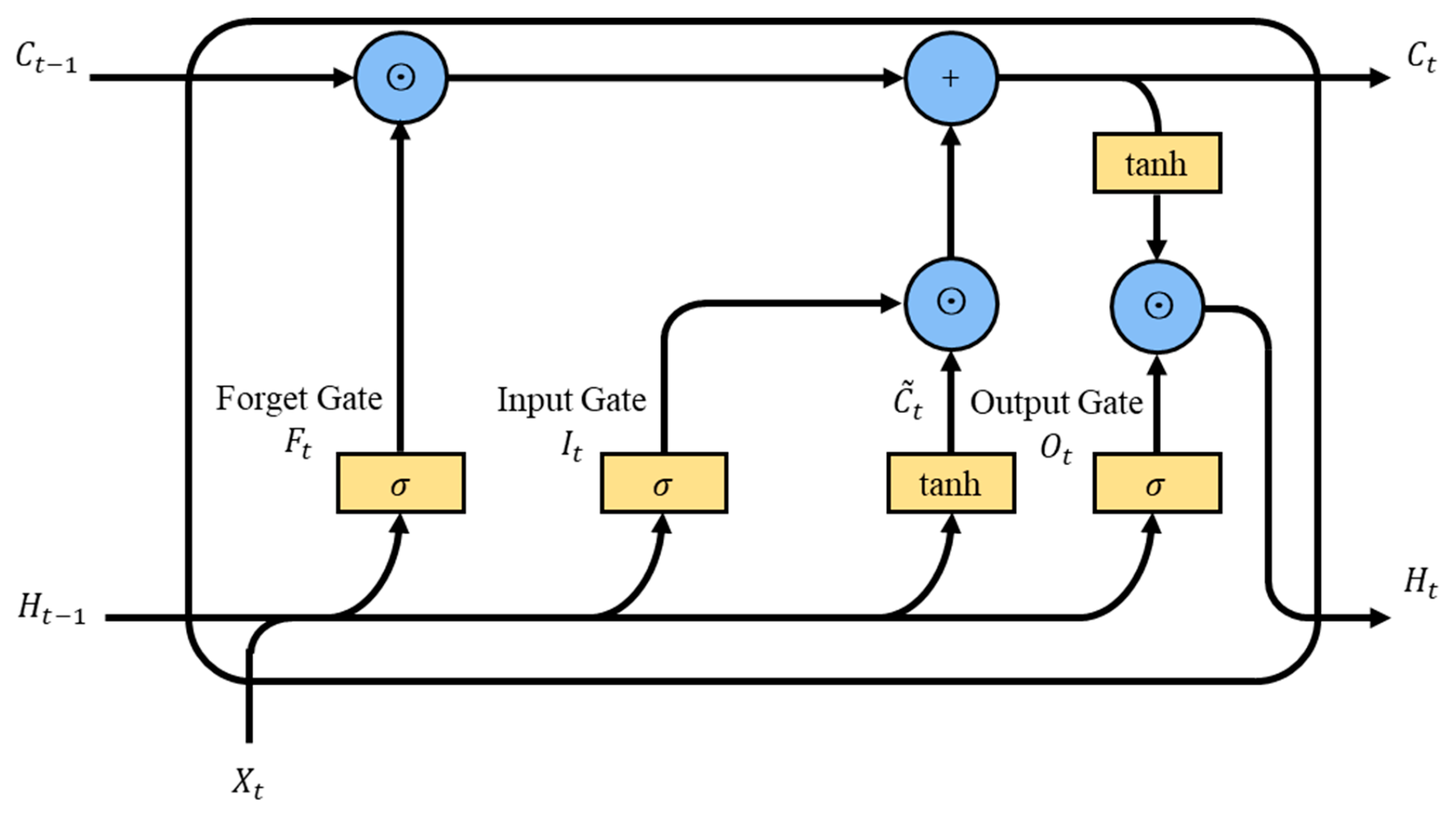
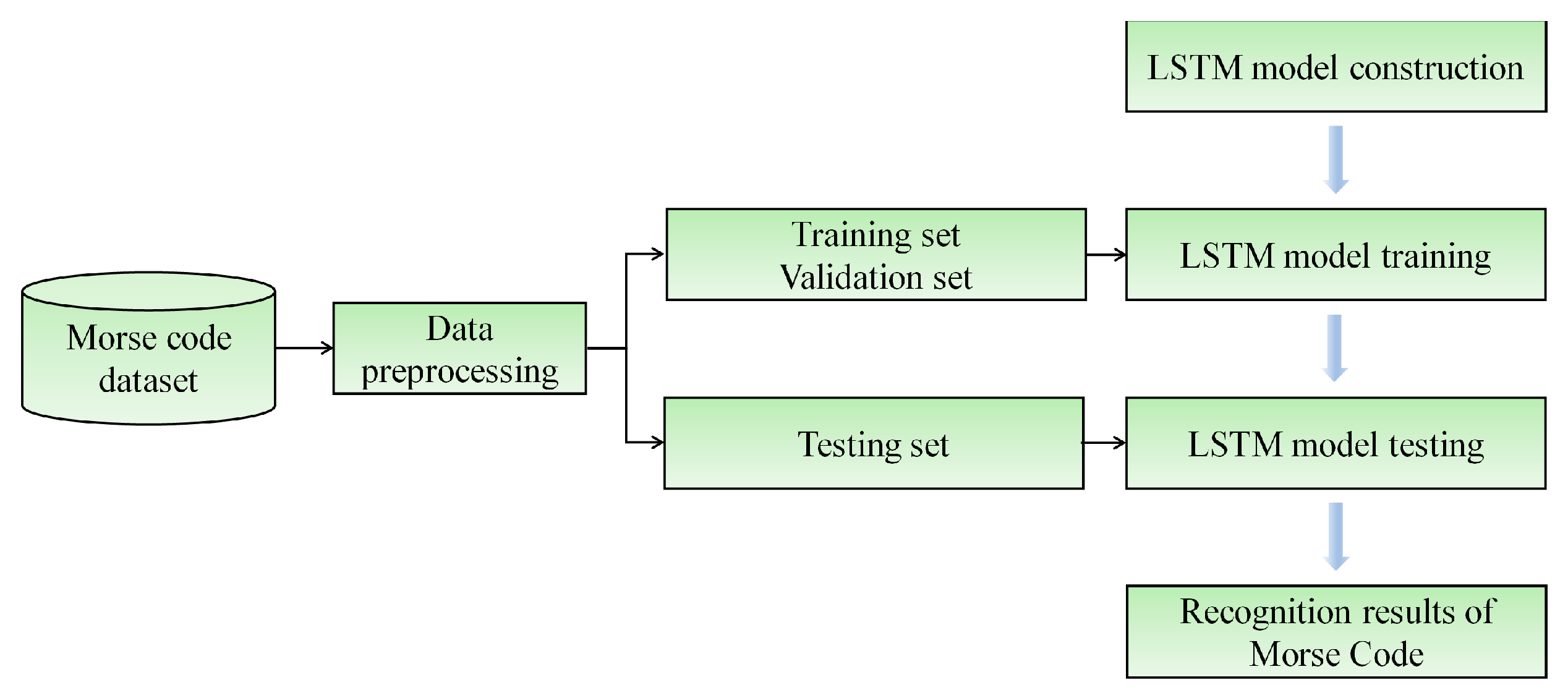
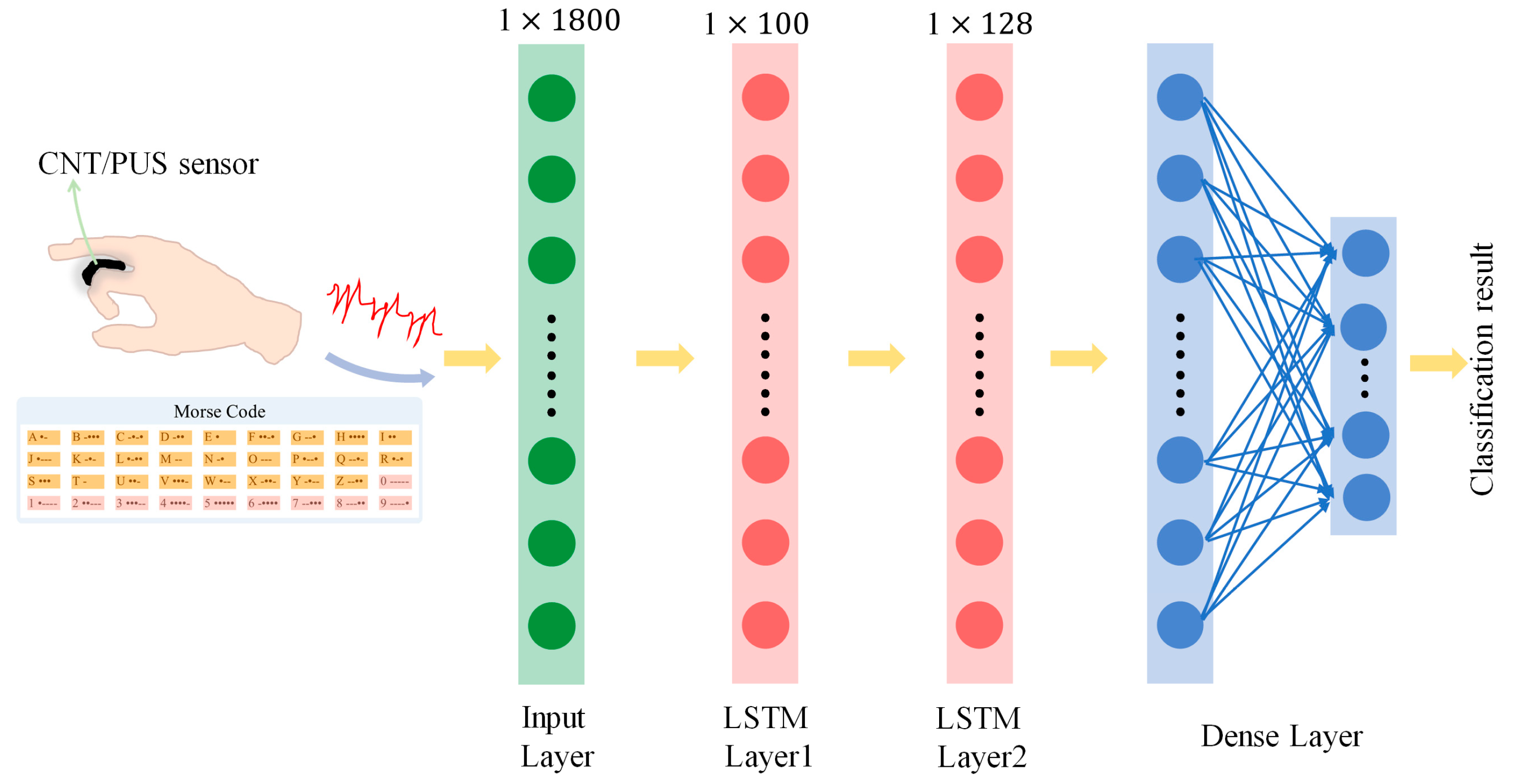
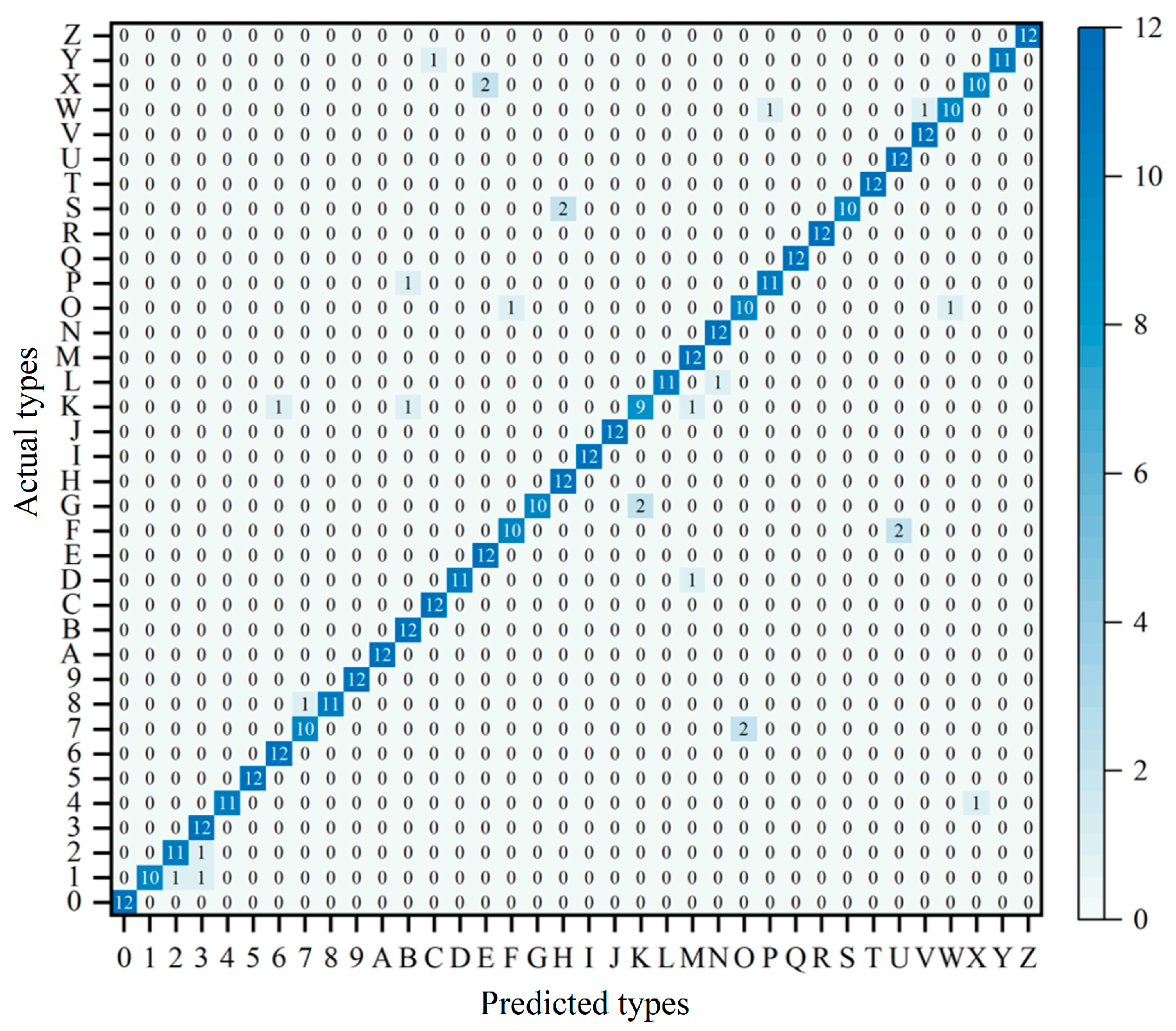
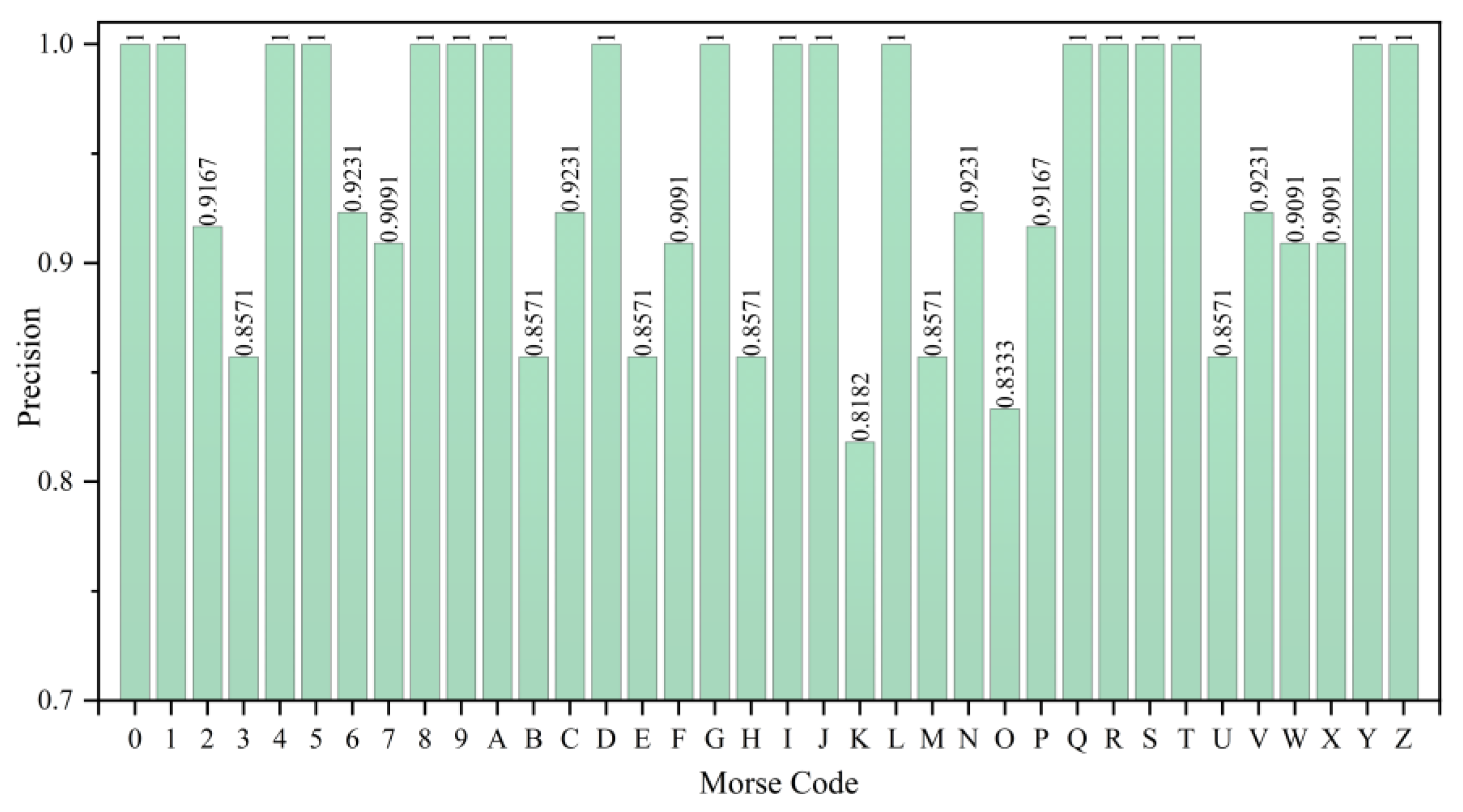

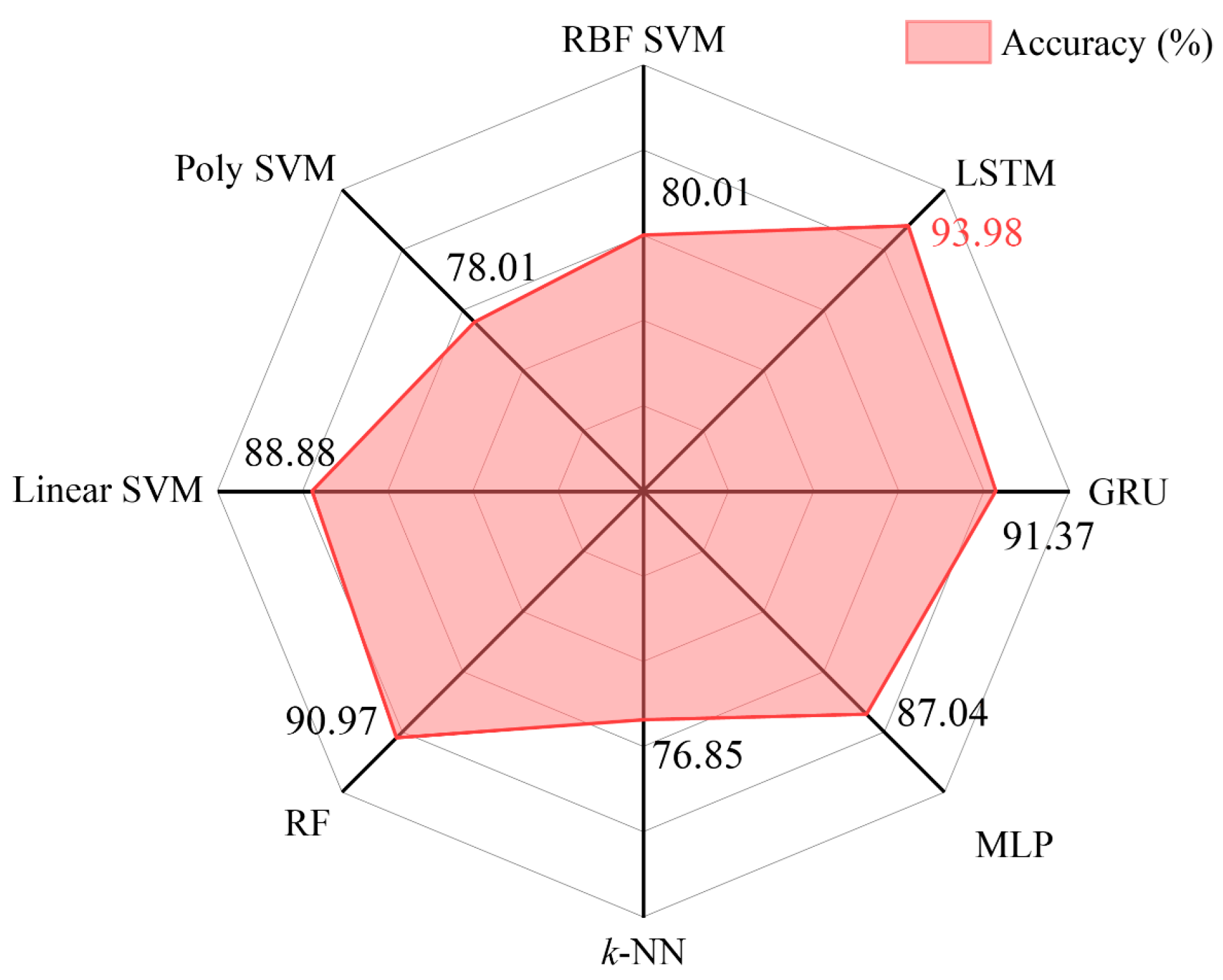
| Properties | Value | Unit |
|---|---|---|
| quality score | 2 | % |
| purity | >98 | % |
| length | 10~30 | |
| diameter | 5~15 |
| Ref. | Materials | Preparation Method | Sensitivity (k·Pa−1) | Response/ Recovery Time (ms) | Repeatability (cycles) | Pressure Range (k·Pa) |
|---|---|---|---|---|---|---|
| This work | CNT/PUS | soaking-drying | 0.027 | 60/100 | 18,000 | 0~100 |
| [28] | MWCNT/PDMS | scraping-coating | 0.026 | 320/170 | 2000 | 0~31.83 |
| [29] | GNPs/MWCNTs/SR | dipping-coating | 0.062 | 45/83 | 2000 | 0~4.5 |
| [30] | MoS2/HEC/PUS | soaking-drying | 0.746 | 120/120 | 2000 | 0~250 |
| [31] | CuRGOMF | dipping-drying | 0.088 | 300/NA * | 5000 | 0~18 |
| Ref. | Principle | Advantages | Disadvantages |
|---|---|---|---|
| This work | Gesture-based | High flexibility | High complexity of recognition |
| [32] | Light-based | Long-distance transmission High-speed transmission | Environment-dependent High visualization requirements |
| [33] | Electrical | High stability Easy to implement | Limited distance Energy-consuming |
| [34] | Electrochromic | Low energy consumption Visually intuitive | Slow response speed Material limitations |
| Index Finger Behavior | Morse Code Meaning |
|---|---|
| Short taps motion | Dot signal |
| Long sliding motion | Dash signal |
| Short pause motion | Interval signal |
| Dataset Status | Dataset | Accuracy | Precision | Recall | F1-Score |
|---|---|---|---|---|---|
| Unprocessed | Morse_10 | 90.74% | 91.90% | 90.74% | 91.32% |
| Morse_26 | 85.07% | 86.12% | 85.07% | 85.59% | |
| Morse_36 | 82.18% | 83.37% | 82.18% | 82.77% | |
| Preprocessed | Morse_10 | 99.17% | 99.70% | 99.17% | 99.43% |
| Morse_26 | 95.37% | 95.71% | 95.37% | 95.54% | |
| Morse_36 | 93.98% | 94.32% | 93.98% | 94.15% |
| Ref. | Sensor | Model | Application | Accuracy |
|---|---|---|---|---|
| This work | CNT/PUS | LSTM | Morse code recognition | 93.98% |
| [38] | Graphene/Nylon | Machine learning | Morse code recognition | >90% |
| [39] | Graphene aerogel | Machine learning | Gestures recognition | 84.7% |
| [40] | CB/PDMS | LSTM + Dense | Gestures recognition | 87.38% |
| [41] | CMOS sensor | YFDM | Morse code recognition | 91% |
| Model | Dataset | Accuracy | Precision | Recall | F1-Score |
|---|---|---|---|---|---|
| LSTM | Morse_10 | 99.17% | 99.70% | 99.17% | 99.43% |
| Morse_26 | 95.37% | 95.71% | 95.37% | 95.54% | |
| Morse_36 | 93.98% | 94.32% | 93.98% | 94.15% | |
| GRU | Morse_10 | 98.33% | 98.57% | 98.33% | 98.45% |
| Morse_26 | 94.22% | 94.61% | 94.22% | 94.41% | |
| Morse_36 | 91.37% | 92.46% | 91.37% | 91.91% | |
| SVM | Morse_10 | 94.17% | 95.19% | 94.17% | 94.68% |
| Morse_26 | 91.35% | 92.29% | 91.35% | 91.82% | |
| Morse_36 | 88.88% | 89.44% | 88.88% | 89.16% | |
| MLP | Morse_10 | 92.50% | 93.76% | 92.50% | 93.13% |
| Morse_26 | 89.42% | 90.42% | 89.42% | 89.92% | |
| Morse_36 | 87.04% | 89.10% | 87.04% | 88.06% | |
| RF | Morse_10 | 97.50% | 98.00% | 97.50% | 97.75% |
| Morse_26 | 94.87% | 95.29% | 94.87% | 95.08% | |
| Morse_36 | 90.97% | 91.68% | 90.97% | 91.32% |
Disclaimer/Publisher’s Note: The statements, opinions and data contained in all publications are solely those of the individual author(s) and contributor(s) and not of MDPI and/or the editor(s). MDPI and/or the editor(s) disclaim responsibility for any injury to people or property resulting from any ideas, methods, instructions or products referred to in the content. |
© 2024 by the authors. Licensee MDPI, Basel, Switzerland. This article is an open access article distributed under the terms and conditions of the Creative Commons Attribution (CC BY) license (https://creativecommons.org/licenses/by/4.0/).
Share and Cite
Wang, F.; Hu, A.; Song, Y.; Zhang, W.; Zhu, J.; Liu, M. Morse Code Recognition Based on a Flexible Tactile Sensor with Carbon Nanotube/Polyurethane Sponge Material by the Long Short-Term Memory Model. Micromachines 2024, 15, 864. https://doi.org/10.3390/mi15070864
Wang F, Hu A, Song Y, Zhang W, Zhu J, Liu M. Morse Code Recognition Based on a Flexible Tactile Sensor with Carbon Nanotube/Polyurethane Sponge Material by the Long Short-Term Memory Model. Micromachines. 2024; 15(7):864. https://doi.org/10.3390/mi15070864
Chicago/Turabian StyleWang, Feilu, Anyang Hu, Yang Song, Wangyong Zhang, Jinggen Zhu, and Mengru Liu. 2024. "Morse Code Recognition Based on a Flexible Tactile Sensor with Carbon Nanotube/Polyurethane Sponge Material by the Long Short-Term Memory Model" Micromachines 15, no. 7: 864. https://doi.org/10.3390/mi15070864
APA StyleWang, F., Hu, A., Song, Y., Zhang, W., Zhu, J., & Liu, M. (2024). Morse Code Recognition Based on a Flexible Tactile Sensor with Carbon Nanotube/Polyurethane Sponge Material by the Long Short-Term Memory Model. Micromachines, 15(7), 864. https://doi.org/10.3390/mi15070864






